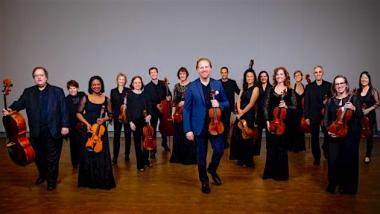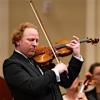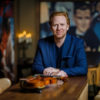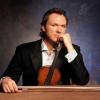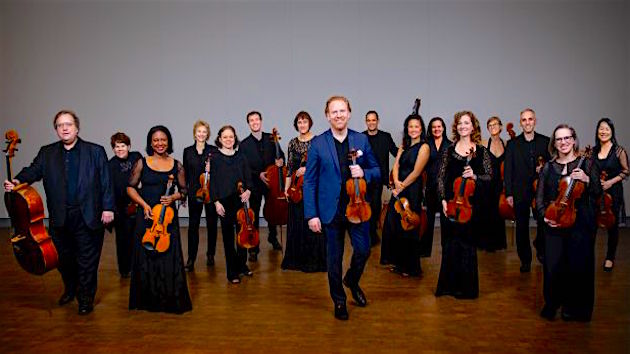
They trod onto the stage of the Hume Concert Hall at the San Francisco Conservatory of Music, wearing their customary black outfits. But the New Century Chamber Orchestra’s “American Masters” program on Saturday night (duplicated over four days at three other venues around the Bay) was itself dressed in folk, show, and jazz colors, with the exception of Samuel Barber’s perennial Adagio for Strings.
Maybe the ensemble wanted to reinforce its user-friendly Yankee cred before heading off next month, following this close of their domestic season, for their debut European tour. The London-raised music director and concertmaster Daniel Hope took care to assert, at the concert’s onset, “Full disclosure: I also love American music,” before noting that the program’s opener — selections from Aaron Copland’s Old American Songs — received its first performance in 1950 by two fellow Englishmen, tenor Peter Pears accompanied by Benjamin Britten on piano.
In this arrangement — by Paul Bateman, also arranger of the evening’s Leonard Bernstein and George Gershwin sets — neither the ensemble nor the composer was shown to the dynamic potential they’ve demonstrated elsewhere. But there was frisky fun in “The Boatman’s Dance” and “Ching-a-ring-Chaw,” positioning Hope out front as star soloist more so than in some other NCCO programs. He took some liberties with the melody of “Simple Gifts” (a standout from Copland’s Appalachian Spring), and it worked sweetly. The entire ensemble blended beautifully on “The Little Horses” and were impressive in unison on the melody of “Ching-a-Ring-Chaw,” but seemed a bit off their intonation with the “altered” chording of “At the River.”
Barber’s Adagio might be the best showcase of the various aspects of a chamber orchestra, and with it, New Century proved itself worthy, not only in delivering the piece’s irresistible empathy and in passing the unforgettable theme between the violin sections and on to violas, cellos, and bass with uniform virtuosity, but also in rendering the warhorse welcome and vital. The players’ trademark black attire seemed particularly fitting in this.
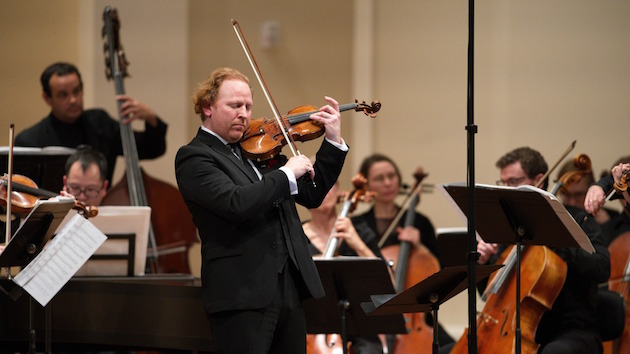
Hope was back in front, standing in for the voice of Maria on “America,” the first of several selections from Bernstein’s score for West Side Story. His bright bowing and sassy slurs had the audience chuckling, and Bateman’s arrangement effectively had cellos and bass dancing Latin underneath the soloing. With Hope affecting a bright cantabile, the setting of “Maria” had listeners missing nothing but the lyrics, the ensemble's backing tugging at their heartstrings.
Hope jumped octaves to good effect on “Tonight,” and partnered dreamily with viola and cello on “Somewhere.” Violas played the part of Anita in her dialogue with Maria (Hope) on “A Boy Like That/I Have a Love,” with both arrangement and performance achieving theatrical credibility, and Hope’s double stopping serving him well. Bongos (apparently uncredited) were deployed on the closing “Mambo,” and the entire ensemble successfully evoked the anguished passion. Hope somehow had himself sounding like a horn.
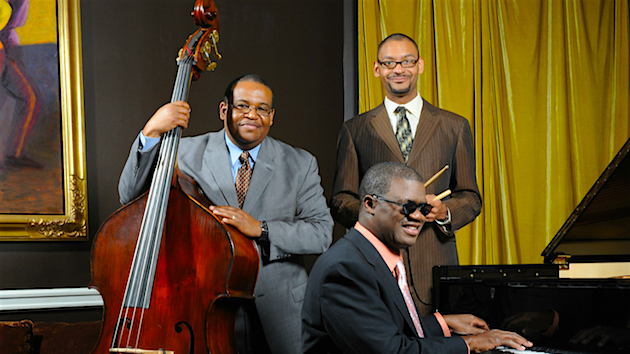
Following intermission, Hope spoke about his having first encountered pianist Marcus Roberts when they were piloting respective classical and jazz programs at the Savannah Music Festival. He then summoned Roberts’s Trio onto the stage, complemented by Rodney Jordan on bass and Jason Marsalis (Wynton’s youngest brother) on drums, for a suite of numbers by George Gershwin. Curiously, the jazz ensemble appeared the more formally attired, in suits and ties. “The orchestra will keep reminding you what the song is,” Roberts promised, “and we’ll see if we can change it into something else.”
As it played out, nobody really strained their improvisational imagination, and so nobody ever got lost. Roberts’s keyboard, its sound somewhat tinny in amplification, comped syncopatedly behind Hope’s lead melodic turn on “Fascinating Rhythm,” and the violinist segued into a solo on “Summertime,” with Marsalis working an evocative New Orleans second-line drag. On his own solos, Roberts seemed reserved, perhaps not wanting to stray far from his classical collaborator cred. In most of this, the NCCO ensemble seemed restricted to the meager, at time gratuitous presence of orchestral strings on some jazz recordings from the 1950s.
Things brightened up a bit on “’S Wonderful,” with Hope offering one of the Gershwin set’s
“forgotten” intros and then channeling the good-natured glee of the late legendary jazz violinist Stéphane Grappelli, partner with guitarist Django Reinhardt in the Quintet of the Hot Club of France. The singing of Hope’s strings enhanced “The Man I Love,” Roberts arpeggiating 16th notes rapidly, suggesting that his strong suit is more technical than improvisational.
On “I Got Rhythm,” everyone had it, and everyone got to sparkle, the entire NCCO wreathed in smiles and visibly looser in body than they had been for the concert’s first half. Jordan picked an artful solo on bass, then switched to high-spirited arco, slyly quoting the “Flintstones” TV theme. Marsalis also showed how much syncopation and variety of sound he had packed in his small kit: bass drum, snare drum, and cymbal.
The NCCO sat out (though remaining on stage, smiling) for an encore by the Trio on Cole Porter’s “It’s All Right With Me,” with Jordan proving that a “walking bass” can take harmonic movement down some unexpected byways. Marsalis, soloing, took the opportunity to display ticklish polyrhythmic patterns against a bass drum pulse, while Roberts demonstrated the acoustic advantage of crossing hands. A reprise of “I Got Rhythm” put the NCCO back in play and sent the audience out sharing the musicians’ manifest pleasure in collaboration.

